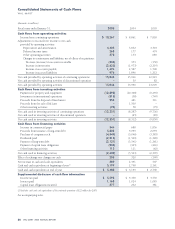Walmart 2005 Annual Report Download - page 34
Download and view the complete annual report
Please find page 34 of the 2005 Walmart annual report below. You can navigate through the pages in the report by either clicking on the pages listed below, or by using the keyword search tool below to find specific information within the annual report.Management’s Discussion and Analysis of
Results of Operations and Financial Condition
W A L -M A R T
32 WAL-MART 2005 ANNUAL REPORT
For a listing of our significant accounting policies, please see
Note 1 to our consolidated financial statements that appear after
this discussion.
New Accounting Pronouncement
On February 1, 2003, the company adopted the expense recognition
provisions of Statement of Financial Accounting Standards No. 123,
“Accounting and Disclosure of Stock-Based Compensation” (“SFAS
123”). Under SFAS 123, compensation expense is recognized based
on the fair value of stock options granted. Upon the adoption of
SFAS 123, we retroactively restated the results of our operations for
the accounting change. Following the provisions of SFAS 123, the
consolidated statements of income for fiscal 2005, 2004 and 2003
include $122 million, $102 million and $84 million, respectively,
of after-tax stock option expense, which is approximately $0.03 per
share in fiscal year 2005 and $0.02 per share for fiscal years 2004
and 2003. In December, 2004, the Financial Accounting Standards
Board issued a revision of SFAS 123 (“SFAS 123(R)”). We adopted
the provisions of SFAS 123(R) upon its release. Prior to the adop-
tion of SFAS 123(R), we used the Black-Scholes-Merton formula
to estimate the value of stock options granted to associates. We
continue to use this acceptable option valuation model following
our adoption of SFAS 123(R). SFAS 123(R) requires that the ben-
efits of tax deductions in excess of recognized compensation cost
be reported as a financing cash flow, rather than as an operating
cash flow as required under previously effective accounting princi-
ples generally accepted in the United States. The adoption of SFAS
123(R) did not have a material impact on our results of operations,
financial position or cash flows.
Forward-Looking Statements
This Annual Report contains statements that Wal-Mart believes are
“forward-looking statements” within the meaning of the Private
Securities Litigation Reform Act of 1995, which statements are
intended to enjoy the protection of the safe harbor for forward-
looking statements provided by that Act. These forward-looking
statements include statements under the caption “Liquidity and
Capital Resources” in Management’s Discussion and Analysis of
Financial Condition and Results of Operations with respect to our
capital expenditures, our ability to fund certain cash flow shortfalls
by the sale of commercial paper and long-term debt securities, our
ability to sell our long-term securities and our anticipated reasons
for repurchasing shares of our common stock. These statements are
identified by the use of the words “anticipate,” “contemplate,”
“expect” and “plan,” and other, similar words or phrases.
Similarly, descriptions of our objectives, strategies, plans, goals
or targets are also forward-looking statements. These statements
discuss, among other things, expected growth, future revenues,
future cash flows, future capital expenditures, future perfor-
mance and the anticipation and expectations of Wal-Mart and its
Management as to future occurrences and trends. These forward-
looking statements are subject to certain factors, in the United
States and internationally, that could affect our financial perfor-
mance, business strategy, plans, goals and objectives. Those fac-
tors include the cost of goods, labor costs, the cost of fuel and
electricity, the cost of healthcare, competitive pressures, inflation,
accident-related costs, consumer buying patterns and debt levels,
weather patterns, currency exchange fluctuations, trade restric-
tions, changes in tariff and freight rates, changes in tax law, the
outcome of legal proceedings to which we are a party, unemploy-
ment levels, interest rate fluctuations, changes in employment
legislation and other capital market, economic and geo-political
conditions. Moreover, we typically earn a disproportionate part of
our annual operating income in the fourth quarter as a result of
the seasonal buying patterns. Those buying patterns are difficult to
forecast with certainty. The foregoing list of factors that may affect
our performance is not exclusive. Other factors and unanticipated
events could adversely affect our business operations and financial
performance. We discuss certain of these matters more fully, as
well as certain risk factors that may affect our business operations,
financial condition and results of operations, in other of our
filings with the SEC, including our Annual Report on Form 10-K.
We filed our Annual Report on Form 10-K for the year ended
January 31, 2005, with the SEC on or about March 31, 2005.
Actual results may materially differ from anticipated results
described or implied in these forward-looking statements as a
result of changes in facts, assumptions not being realized or
other circumstances. You are urged to consider all of these risks,
uncertainties and other factors carefully in evaluating the forward-
looking statements. The forward-looking statements included in
this Annual Report are made only as of the date of this report,
and we undertake no obligation to update these forward-looking
statements to reflect subsequent events or circumstances.
























